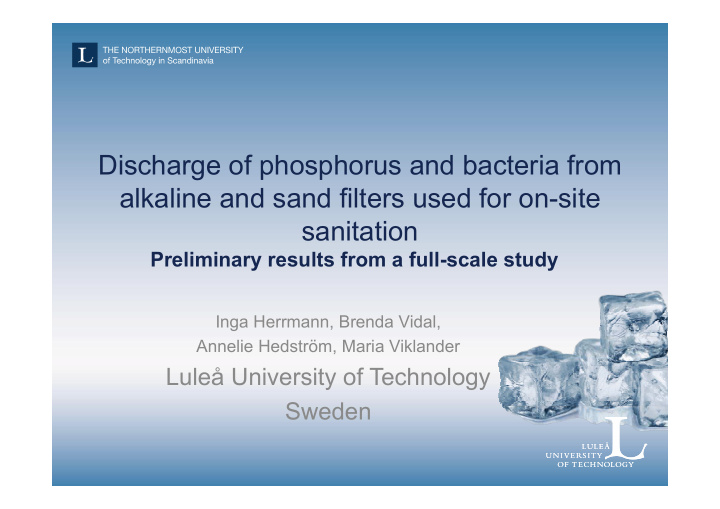



Discharge of phosphorus and bacteria from alkaline and sand filters used for on-site sanitation Preliminary results from a full-scale study Inga Herrmann, Brenda Vidal, Annelie Hedström, Maria Viklander Luleå University of Technology Sweden
On-site wastewater treatment Problem: discharge of P and bacteria Sand filter P filter Household Septic tank Biological Filter bed for treatment: P treatment Sand filter
On-site wastewater treatment 3. Phosphorus filter 1. Septic tank 2. Sand filter
Sand filter design 70 cm layer of sand/gravel 4-8 mm
P filter design
P filter design
Methods Identification of suitable on-site facilities – Co-operation with 4 municipalities – Contact with 37 property owners – Inspection of 29 facilities: sampling possible? Flow measurement possible? 5 sand filters and 2 P filters were sampled Sampling during a few hours in the morning and evening to cover consumption peaks
Methods: Sampling Samples taken at inlet and outlet of sand filters and P filters Flow-proportional sampling, manual flow measurement 2 composite samples taken at each occasion
Methods: Analysed parameters Total and dissolved P Bacteria – E. Coli – Intestinal enterococci – C. perfringens – Total coliforms TOC, DOC, BOD pH temperature
Results
Discharge of P from sand and P filter 1 Sand filter, inlet Sand filter, outlet P filter, outlet
Bacteria discharge from sand filters
Conclusions (1) Flow-proportional sampling of private on-site WW facilities impeded by: – Un-informative municipal databases – Owners’ good will – Facility’s design, installation, function Therefore, it is difficult to assess the function of on-site units at full scale. Generally rather low concentrations of total P in the outlets of the sand filters, possibly also due to dilution with soil water.
Conclusions (2) The two investigated P filters varied in performance. The ow P concentrations measured in the influent to the P filters make it difficult to generally assess the P filters’ efficiency. Concentrations of four indicator bacteria, intestinal enterococci, E. coli , total coliforms and C. perfringens , were reduced in four of the five investigated sand filters. Varying between seasons.
Thank you for your attention!
Recommend
More recommend